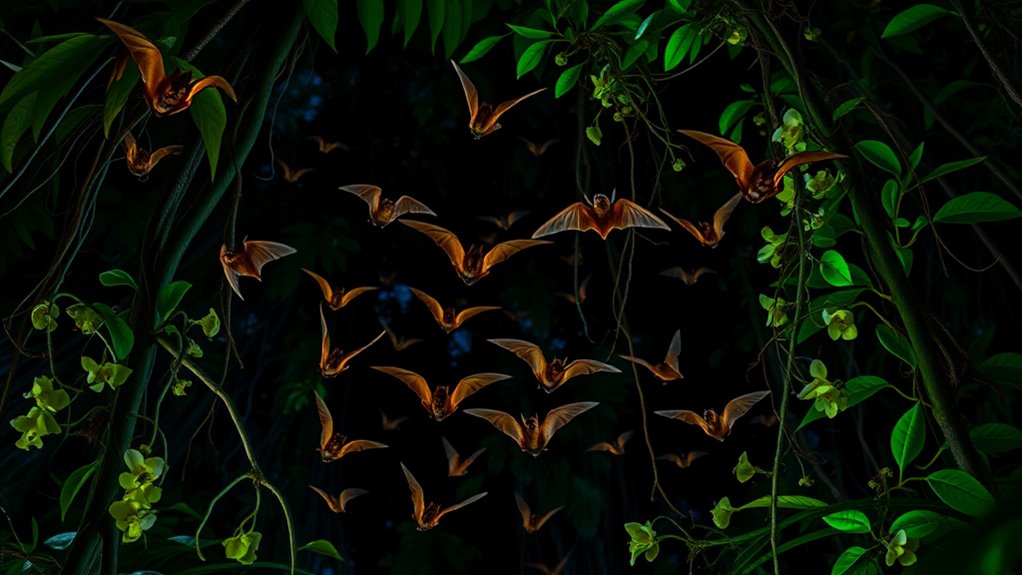Bats play a essential role in pollination, supporting over 500 plant species worldwide, including fruits like mango and bananas. They’ve adapted to thrive at night with keen echolocation, scent detection, and long tongues that reach deep flowers. Their nighttime activity benefits ecosystems and economies, especially in remote areas. Because of threats like habitat loss and climate change, protecting bats is necessary. Discover more secrets about these critical pollinators and their night-time adventures.
Key Takeaways
- Bats poll over 500 plant species, including vital fruits like mango and banana, supporting ecosystems and economies globally.
- Their nocturnal adaptations, such as echolocation and acute smell, enable effective nighttime foraging and flower detection.
- Long-distance flight helps pollinate isolated and widely spaced plants, ensuring biodiversity and ecosystem resilience.
- Bat pollination is crucial for the reproduction of plants that provide food, habitat, and economic resources.
- Threats like habitat loss and climate change endanger bat populations, making conservation efforts essential for maintaining pollination services.
The Diversity and Importance of Bat Pollinators Globally

Across the globe, over 500 flowering plant species from at least 67 plant families depend heavily on bats for pollination. You might not realize it, but these plants rely on bats to reproduce, especially in tropical and desert regions. Nectar-feeding bats, including American leaf-nosed bats and Old World flying foxes, have evolved specific traits to visit flowers at night. These flowers tend to be large, pale, and emit strong fragrances to attract bats. By pollinating plants like mango, banana, durian, and saguaro cacti, bats support ecosystems and economies worldwide. Their ability to travel long distances helps plants in isolated habitats. Without bats, many of these essential plants would struggle to survive, highlighting their indispensable ecological and economic roles.
How Bats Adapt to Nighttime Flowering and Nectar Feeding

Bats have evolved remarkable adaptations that enable them to thrive as nighttime flower visitors and nectar feeders. Their keen senses and physical traits help them locate and access flowers in the dark.
- Echolocation: Bats emit high-frequency calls, allowing them to navigate through darkness, pinpoint flower locations, and avoid obstacles.
- Enhanced Olfaction: They rely heavily on their sense of smell to detect strong fragrances from bat-pollinated flowers, especially those emitting fermenting or fruit-like scents.
- Long, Specialized Tongues: Many nectar bats have extendable, brush-tipped tongues that efficiently extract nectar from deep or large flowers.
- Robust Fur and Pollen Transfer: Their dense fur captures and carries substantial pollen loads, increasing pollination success during their nightly foraging.
- Nocturnal Activity Patterns: Their nocturnal foraging behaviors are further supported by their adaptations to low light conditions, which help them maximize their pollination efficiency under the cover of night. Additionally, these adaptations are complemented by their specialized sensory capabilities, enabling them to thrive in dark environments.
The Ecological and Economic Impact of Bat Pollination

Bat pollination plays a crucial role in maintaining both ecological balance and economic stability worldwide. By pollinating over 500 plant species, bats support the reproduction of fruits like mango, banana, and guava, which are vital for food security and local economies. They also pollinate plants such as agave and cacti, essential for products like tequila and desert ecosystems. Your reliance on bat-pollinated crops underscores their economic importance, contributing billions to global agriculture. Ecologically, bats help sustain biodiversity by supporting plant populations that provide habitat and food for countless species. Their long-distance flight allows them to pollinate isolated or widely spaced plants, ensuring ecosystem resilience. Protecting bat populations directly benefits both the environment and human livelihoods, highlighting their vital ecological and economic contributions.
Challenges Facing Bat Pollinators and Conservation Efforts

Despite their important role in supporting biodiversity and agriculture, bat pollinators face numerous threats that jeopardize their populations. Habitat loss from deforestation, agricultural expansion, and urbanization reduces available roosting and foraging sites. Climate change alters flowering schedules, disrupting pollination timing. Human activities such as mining, caving, and hunting directly disturb or kill bats. To address these challenges, conservation efforts focus on:
Bat populations face threats from habitat loss, climate change, and human activities, risking vital pollination services.
- Protecting and restoring natural habitats and roosting sites.
- Implementing legal protections for vulnerable bat species.
- Promoting awareness to reduce persecution and hunting.
- Supporting research on bat ecology and population trends. Additionally, understanding the bat’s natural habitats helps tailor effective conservation strategies. Efforts to conserve bat habitats also include promoting sustainable land-use practices that benefit both bats and local communities. Recognizing the importance of habitat preservation is crucial for maintaining healthy bat populations and their pollination services. Studies on bat ecology provide valuable insights into their behavioral patterns and ecological needs, aiding in the development of targeted conservation measures. Enhancing our knowledge of bat dietary habits can further improve habitat management practices. These strategies aim to stabilize bat populations and preserve their essential pollination services for ecosystems and economies alike.
Unique Behaviors and Research Insights Into Bat-Plant Interactions

Research into bat-plant interactions reveals fascinating behaviors that enhance pollination efficiency and plant survival. You’ll find that bats have evolved unique adaptations to locate and access flowers. Their keen echolocation helps them navigate at night, pinpointing large, pale, and fragrant blossoms designed to attract them. Bats often feed on copious nectar and pollen, which they carry in their dense fur, boosting pollination success. Some species migrate seasonally to synchronize with flowering cycles, demonstrating remarkable behavioral flexibility. Studies show that bat fur qualities influence flower evolution, encouraging plants to produce more pollen to ensure transfer. Additionally, environmental factors such as habitat loss and climate change threaten these intricate pollination interactions, potentially disrupting ecosystem stability. Long-term research highlights how environmental changes impact these interactions, underscoring the importance of conserving bat behaviors and habitats to maintain healthy ecosystems and the essential pollination services they provide.
Frequently Asked Questions
How Do Bats Locate Flowers in Complete Darkness?
You might wonder how bats find flowers in total darkness. They rely on echolocation, emitting high-pitched sounds that bounce off objects, including flowers. By listening to the returning echoes, bats create a mental map of their surroundings, pinpointing flower locations. Additionally, they are attracted to strong fragrances and large, pale flowers that are easier to spot at night, guiding them directly to their nectar sources.
What Specific Flower Traits Attract and Accommodate Bat Pollinators?
You’ll notice that bat-pollinated flowers are designed to be irresistibly attractive at night, with traits like large size, white or pale colors, and strong fermenting scents that seem to call bats like a beacon. These flowers produce copious nectar and emit powerful fragrances to lure bats in. Their abundant pollen and long floral tubes perfectly accommodate bat anatomy, ensuring efficient pollination and making these plants a crucial part of ecosystems worldwide.
How Do Bat Migration Patterns Influence Plant Pollination Cycles?
You see, bat migration patterns directly influence plant pollination cycles by aligning bat presence with flowering times. As bats migrate seasonally, they visit plants blooming during their journey, ensuring pollination occurs when flowers are receptive. This synchronization helps plants reproduce successfully across vast distances, particularly in desert and tropical environments. Your understanding of these patterns highlights the importance of conserving migratory routes to maintain healthy ecosystems and food sources.
What Are the Most Effective Conservation Strategies for Bat Pollinators?
For effective bat pollinator conservation, prioritize protecting their habitats and roosting sites. Implementing innovative infrastructure, like insect-proof caves and safe sanctuaries, helps shield bats from threats. Support sustainable farming and forestry practices that preserve floral resources. Additionally, promote public awareness and community involvement to reduce hunting and habitat destruction. By blending bold policies with grassroots efforts, you can bolster bat populations and bolster biodiversity, ensuring these essential pollinators thrive.
How Do Bat Fur and Pollen Transfer Compare to Insect Pollinators?
You’ll find that bat fur, being dense and sticky, carries more pollen than most insect pollinators. Bats can transfer larger pollen loads because their fur effectively traps pollen grains as they visit flowers at night. Unlike insects that visit multiple flowers quickly, bats fly longer distances and visit fewer flowers per trip, making their pollen transfer more efficient for certain plants, especially those adapted for nocturnal pollination.
Conclusion
You might think that bats are just creatures of the night, but their role as essential pollinators impacts ecosystems and economies worldwide. Without them, many plants and crops would struggle to survive, threatening food security and biodiversity. Even if you’re afraid of bats, understanding their importance helps you see them as indispensable allies in nature’s delicate balance. Protecting these nocturnal pollinators ensures a healthier planet for everyone, including future generations.







